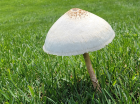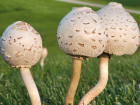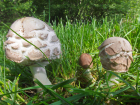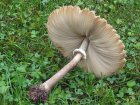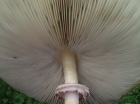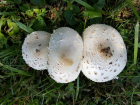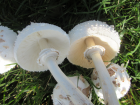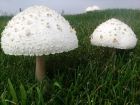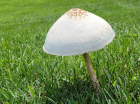Cap convex to bell-shaped and has a slightly incurved margin when young, expanding to a broadly convex shape as it matures. The surface is first covered by a thin layer of shiny, pale pinkish-buff volva tissue that soon cracks into scales, exposing the white cap surface. The scales are brown to pinkish-brown or tan, either uplifted or flat, and usually concentrated near the centre. The flesh is thick, and white throughout. Gills close, broad, free and remote from the stem, pale yellowish but becoming greyish green to brownish green as the spores mature. Stem slender, enlarged towards the base, white to brownish and bears a double-edged ring that is white at first but becomes brown and scaly on the underside. Spore print dull grayish green.
Microscopic Features: The spores measure 9-13 x 6-9 µm and have an amygdaliform to ellipsoid shape. They are smooth and slightly truncated at one end, featuring a small 1 µm pore. The spores have thick walls and appear hyaline (colourless) to faintly greenish in KOH (potassium hydroxide). Additionally, they exhibit dextrinoid properties.
Chlorophyllum molybdites on the MushroomExpert.Com Web site.
Identifying the Most Common Poisonous Mushroom: Chlorophyllum molybdites on the Foraged Foodie Web site.
The seventh photo is by Sylvia and licensed under the Creative Commons Attribution 3.0 Unported license.
Many mushrooms are poisonous, and some can be lethally toxic. Distinguishing between edible and poisonous mushrooms can be very challenging. Therefore, we strongly advise against consuming wild mushrooms. This website does not contain any information about the edibility or toxicity of mushrooms.
Although efforts have been made to ensure accuracy on this website, the information may contain errors and omissions. Therefore, all content provided is for educational and informational purposes only and should not be relied upon or used as a basis for consuming any plants or mushrooms.
External links are provided for reference only. We do not endorse or take responsibility for the content, advice, or products found on these sites or in any advertisements shown on this website.
